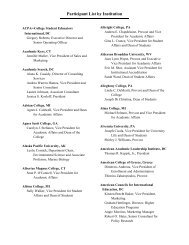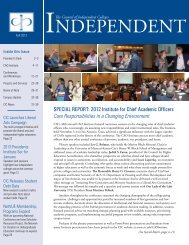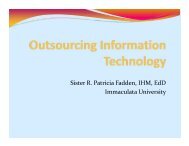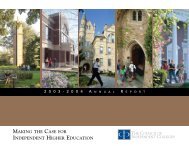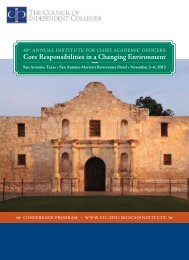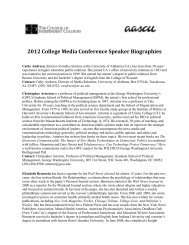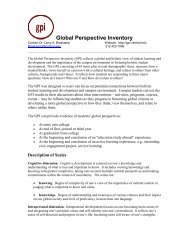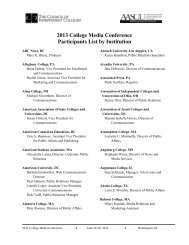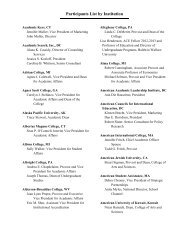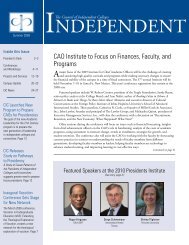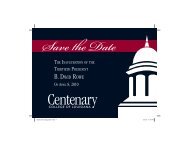Winter/Spring 2003 - The Council of Independent Colleges
Winter/Spring 2003 - The Council of Independent Colleges
Winter/Spring 2003 - The Council of Independent Colleges
- No tags were found...
Create successful ePaper yourself
Turn your PDF publications into a flip-book with our unique Google optimized e-Paper software.
PRESIDENTS INSTITUTEToday’s and tomorrow’s students differ in importantways from previous cohorts, and campusesmust recognize and address those differences,said Shawn Coyne (pictured), co-president andCEO <strong>of</strong> CONNEXXIA and Thomas Williams,president and CEO <strong>of</strong> Noel-Levitz.(Today’s Students, cont’d from page 16)process. Coyne reported that virtuallyall (94 percent) <strong>of</strong> today’s students haveaccess to the Internet, with the mostimportant usage by far being for e-mail(63 percent) rather than for schoolwork(39 percent), research, or other uses.However, Coyne stressed, they overwhelminglyuse the internet for collegeand admissions information (63 percentsaid the internet was the top source <strong>of</strong>college information)—and they areuniformly unimpressed with collegewebsites.In response to these criticisms,Connexxia conducted an analysis <strong>of</strong> collegewebsites and found that the students’impressions are well founded.“Most websites do not present informationin an exciting, user-friendly way;have sub-optimal graphics; are clutteredand difficult to navigate; and containstatic information, at least some <strong>of</strong>which is out <strong>of</strong> date,” Coyne said. Inaddition, virtually none are truly interactiveor establish a “human connection.”Coyne <strong>of</strong>fered a number <strong>of</strong> suggestionsfor colleges looking to attract theseprospective students:Sharpen your message—studentsnow investigate more options thanever before, and you must differentiateyourself;Deliver your message moreeffectively—make it exciting and userfriendly,update it frequently, and personalizeor tailor it;Establish the “human connection”by facilitating two-way communicationwith admissions staffers, selected studentsand your institution’s key players,including the president; andOptimize your media mix—hardcopy documents are still vital, but theinternet is now your most indispensablemedium.Both the Noel-Levitz and Connexxiapresentations are available on CIC’s websiteat www.cic.edu/conferences_events/presidents/previouspres/<strong>2003</strong>resources.asp.Presidents Need to TackleAlcohol Abuse on CampusCollege presidents must take action tochange the culture <strong>of</strong> drinking on campus,said Presidents Institute panelistSusan Resneck Pierce, president <strong>of</strong>University <strong>of</strong> Puget Sound (WA), duringa session on the president’s role inaddressing campus drinking.More college students are drinking toget drunk and engaging in risky behavior(for example, driving under theinfluence and having unprotected sex),she said, noting that “1,400 college studentsdie each year because <strong>of</strong> alcohol,500,000 are injured, 600,000 are assaulted,and 70,000 are victims <strong>of</strong> date rapeor sexual assault.” Pierce cited a recentreport from the National Institute onAlcoholism and Alcohol Abuse TaskForce (NIAAA), A Call to Action:Changing the Culture <strong>of</strong> Drinking atU.S. <strong>Colleges</strong>. Pierce served on theNIAAA’s Task Force on CollegeDrinking.Given the magnitude <strong>of</strong> the problem,she said it is important for college presidentsto tackle the issue. She suggesteda number <strong>of</strong> actions presidents couldtake that might have a positive impacton campus drinking:• Work with students on an individuallevel;• Make substance abuse prevention apriority;• Educate faculty members about howalcohol abuse leads to academic problems(25 percent <strong>of</strong> students reporthaving academic problems related toalcohol abuse) and persuade facultymembers to join in efforts to addressthe problem;• Step up the enforcement <strong>of</strong> the minimumdrinking age law;• Work with <strong>of</strong>f-campus bars andnightclubs on responsible serving;• Educate students about alcohol poisoning;• Create alcohol-free living spaces andhost alcohol-free events;• Eliminate keg parties on campus, andeliminate alcohol at sporting events,including banning tail-gate parties;and• Conduct a social norms campaign toeducate students that there is actuallyless drinking than they think there is;students tend to want to conform,and if they think more students aredrinking, they might feel more pressureto do so themselves.Following her stint on the AlcoholAbuse Task Force, Pierce undertook amajor alcohol awareness campaign atthe University <strong>of</strong> Puget Sound. She saidthe institution now “rents security personnel/policeon the weekends to patrolthe <strong>of</strong>f-campus neighborhoods, whichhas significantly improved the campus’relations with the neighbors; notifiesparents <strong>of</strong> students with major or chronic<strong>of</strong>fenses (which has led to very fewrepeat <strong>of</strong>fenders); has adults living in all<strong>of</strong> the residence halls; sponsors a lot <strong>of</strong>midnight breakfasts with live music;schedules a variety <strong>of</strong> orientation activitieson alcohol abuse and alcohol policieson campus; and disallows alcoholrelatedadvertising on campus.She encouraged presidents to obtainthe college materials kit from theNIAAA, which contains a copy <strong>of</strong>every publication released by the TaskForce on College Drinking. <strong>The</strong> kit canbe ordered online at www.collegedrinkingprevention.gov.<strong>Independent</strong> 17 www.cic.edu<strong>Winter</strong>/<strong>Spring</strong> <strong>2003</strong>



